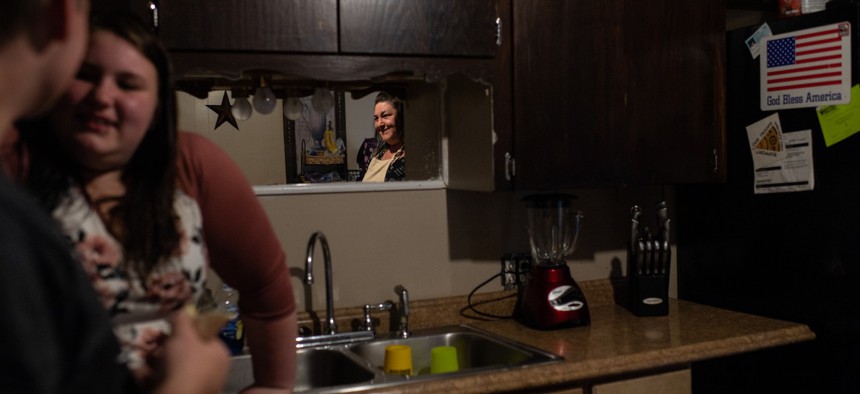Connecting state and local government leaders
A program in Tulsa, Oklahoma, has been changing lives for addicted women and their children. Here’s how it works.
This time of year, we can’t go on social media without seeing photographs of high school and college graduations. These images always move us. But in April, we were able to virtually attend a graduation unlike any other we’ve ever seen. It occurred in Tulsa, Oklahoma, and the 20 graduates had just completed a program called Women in Recovery. The new grads had an accumulated 276 years of drug and alcohol addiction, and had entered the program facing a collective 143 years of prison.
Decked out in carefully chosen celebratory graduation clothes, they accepted their certificates while dismal photos from their years of addiction or the day they were booked by the police flashed on the screen. They shared memories from their past lives and hopes for the new world the program had opened up to them.
Women in Recovery is designed to take women off the path to prison and onto a road to a fulfilling self-sufficient life. Its services address multiple needs: 500 hours of individual and group therapy to deal with addiction, underlying mental health issues and past trauma; help with parenting and the often difficult task of reuniting with children; and assistance with family relations, housing, education and stable, meaningful employment with livable wages. At the same time, the program offers women help in dealing with the many collateral issues that often result in ongoing contact with criminal courts—unpaid fines, suspended driver’s licenses, misdemeanors and parental rights issues.
The majority of women in local jails—nearly 80% of them—have minor children. “We do a lot of work around parent education, parent visitation, teaching parents about ages and stages, and how to learn how to reconnect and bond with your children,” says Mimi Tarrasch, chief program officer for Women in Recovery and Women's Justice Programs at Family & Children's Services, the largest behavioral health organization in the state, which serves about 125,000 individuals throughout Tulsa County.
Seeing these women graduate is particularly heartening given past studies that have shown the negative effects of a parent’s incarceration on their children, with a higher incidence of depression, antisocial behavior, untreated mental health issues and drug addiction. One study found that children of incarcerated parents were six times more likely to end up in prison themselves.
How Lives Are Changed
Women in Recovery started with a small group of 25 women in 2009. Today, it has 110 participants, with room to grow, and has graduated 638 women.
Women who enter the program are typically in jail awaiting sentencing. If the court and the program itself are willing to accept someone, actual sentencing is put on hold until she either drops out of the program (and then heads to prison) or graduates and meets with the judge, who has generally seen her on a monthly basis throughout the year-and-a-half to two-year program. Each visit is accompanied by a written report that details progress on education, employment, housing, parenting and therapy.
The women themselves must agree to join the program and not everyone wants to. “It’s a commitment,” says Rachel Delcour, director of criminal justice for Women in Recovery and Women’s Justice Programs. “It’s not rainbows and sunshine and I make that clear. It’s hard work. Changing your life is hard.”
Currently, women are referred to the program by judges, prosecutors, defense attorneys or through an assessment initiated by Delcour. These are women who have been charged with a felony and may face sentences of up to 10 years, or even more, in prison. Their sentences generally involve drug charges, but can also include child neglect, theft, robbery, dealing drugs or prostitution. Potential candidates go through an assessment of needs and potential risk.
To Lani Burns, who directs the employment and education program for Women in Recovery, the comprehensive and continuing support given to women is a key factor. “Most of us have people in our lives who provide healthy support systems,” she says. “Often for these women, that’s who we are. If we can catch problems early enough through preventative efforts, there’s usually things that we can do to help circumvent negative outcomes.”
Fourteen years after Women in Recovery started, the number of women from Tulsa entering Oklahoma prisons has been reduced by more than 70%, according to Delcour. Of the 20 women who graduated from the program in April, all, except for one who is on long-term disability, have full-time jobs. Average pay is $18 an hour, with Burns noting that this graduating class was the first to be able to take advantage of several new vocational training partnerships that prepare women to fill positions in understaffed occupations that have good benefits and room for advancement. The trainings, for instance, prepare women to be welders or instruct them to install fiber-optic cable, an in-demand skill as the country ramps up its efforts to expand broadband.
The Program’s Roots
Women in Recovery came out of a study commissioned more than 14 years ago by the Tulsa-based George Kaiser Family Foundation, which was seeking to identify critical unmet needs within the City of Tulsa and Tulsa County.
The study uncovered a startling fact: Oklahoma had the highest rate of female incarceration in the United States—twice the national average, according to Amy Santee, chief program officer at the foundation. As she recalls, “Women who were suffering from addiction and untreated mental illness were being driven into our criminal legal system, and the majority of these women were mothers with two to three children.”
The high rate of incarceration had received little attention in the state or in Tulsa County, which was responsible for an alarmingly high percentage of the women entering Oklahoma prisons, relative to the county’s size. “Not only was the unusually high incarceration not being discussed, but neither was its devastating impact on women, children and the broader community,” Santee says.
To develop the program, the foundation turned to Tarrasch, who was then director of Early Childhood Programs at Family & Children’s Services. She agreed to take on the new criminal justice initiative and spent the next year studying research that focused on women in prison and their children. She interviewed academics who specialized in these issues and combed the literature for evidence-based research. “I really tried to understand the pathways that bring women into the criminal legal system, and it often starts with family dysfunction. When you look at the female prison population, there are high rates of physical and sexual abuse and neglect that’s been untreated.”
There are also frequently problems with addiction, both to alcohol and to legal and illegal drugs. “And what doesn’t happen to men, is they get pregnant—often many times during the height of addiction,” Tarrasch says. “And when there’s criminal legal involvement, everybody is in poverty. They’ve struggled in their addiction and untreated mental illness for a very long time. They’ve lost houses. They’re unsheltered. They’ve lost their car and their children.”
After graduation, women in the program are often given a short probation, and if all goes well, the sentence is then expunged and no conviction stays on the person’s record. Judges also have the option to suspend sentencing and issue a longer probationary period—a decision that Delcour views as far less preferable because when a conviction stays on the woman’s record, it is likely to derail opportunities for future employment or housing.
Membership in Women in Recovery is for life, so even when active participation in the program is finished, women can still call on its continuing care program for help. Anybody can come back for anything—if they’re struggling, relapsed, need a mentor or therapist, or access to medical assistance. “Or maybe, they just want to come for lunch or to explore new career opportunities,” says Tarrasch.
The Potential for Similar Approaches Elsewhere
When cities learn about Women in Recovery, the question often arises as to whether other local governments can replicate the model themselves. “We hear a lot about why other jurisdictions can’t do it,” says Delcour. “They always talk about funding.”
But as Santee points out, the program costs about the same as one year in prison, “and the women in this program would potentially be facing many, many years in prison.”
In addition, when women have graduated from the program, Santee says, “we have seen that they are stable in their recovery. They are living in safe housing, have secure employment and are a part of a comprehensive network, dedicated to supporting their journey. Many of them have even been reunified with their children. This experience is very different from many women who are exiting prison without access to substance use treatment, employment or reunification services. The contrast between the two paths is stark, and so are the outcomes.”
For other entities that see the Women in Recovery results and are contemplating a similar program, Burns has the following advice: “Use evidence-based practices. Know your community. Know what the in-demand occupations are [so that] you are filling a need that the community has while also filling a need for those you’re serving.”

NEXT STORY: Staffing Challenges Spur Another Look at Four-Day Workweeks




